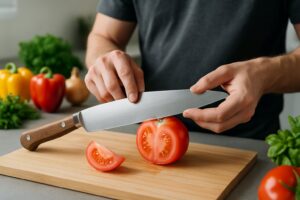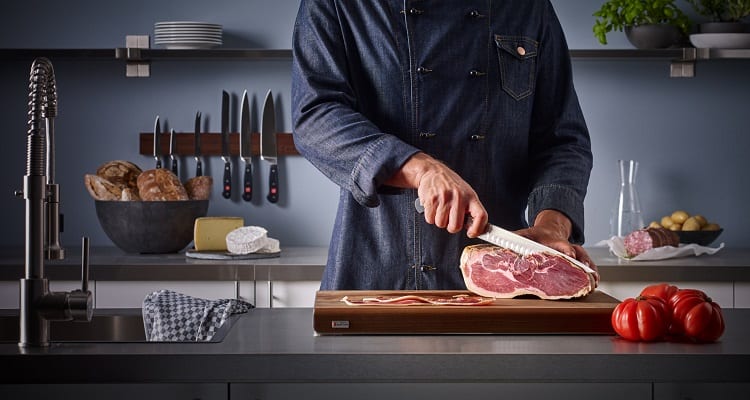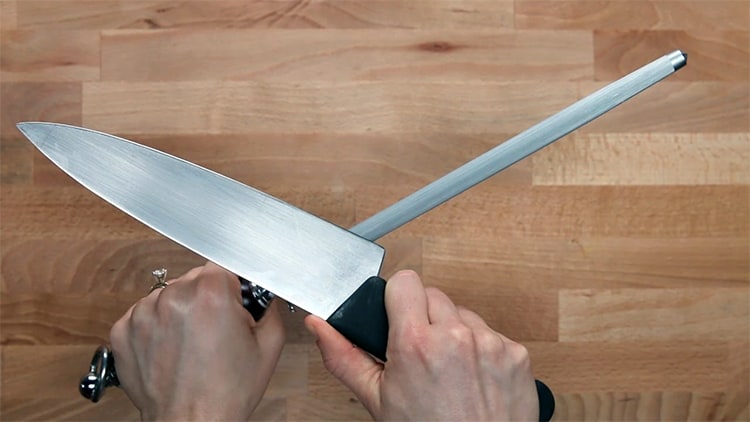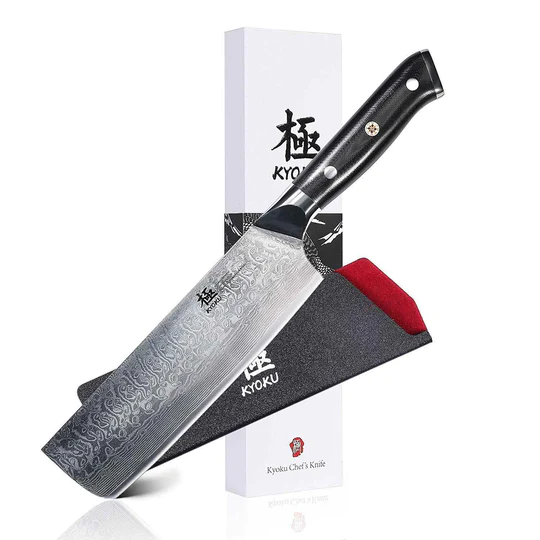


Cutting through meat and bone isn’t as simple as grabbing any knife. You need some muscle and the right tools. What you pick depends on how thick the bone is, how much control you want, and the cut you are after.
The best knife for the job is a heavy-duty meat cleaver or a specialized bone saw. These tools are built for strength and safety. If you try using a regular chef’s knife or a butcher’s knife, you could damage the blade, or worse, hurt yourself.
| Tool | Best For | Not Good For |
|---|---|---|
| Butcher Knife | Trimming, sectioning meat | Dense bones |
| Cleaver | Chopping through bone/meat | Sawing large dense bones |
| Bone Saw | Cutting thick, hard bones | Precise meat cuts |
A butcher’s knife, meat cleaver, and bone saw all bring something different to the table. Butchers knives are large and heavy. They are great for sectioning meat, but not really built for cutting thick bones.
Cleavers have a wide, thick, rectangular blade that’s perfect for chopping through small to medium bones like chicken legs or pork ribs. Cleavers and saws often get used together when breaking down big cuts. Bone saws are your best bet for large or dense bones that will wreck a knife blade.
Butchers use bone saws, either by hand or with power, to process whole carcasses or thick beef bones. If you want a clean cut through strong bone without shattering it, a good bone saw is recommended.
A butcher’s knife usually sports a wide, curved blade between 6 and 14 inches. The thick spine adds some heft, but it’s not designed for heavy bone. The sharp edge lets you slice cleanly through meat, fat, and small joints.
Comfort matters. The handle should feel good and offer a non-slip grip, with enough balance for safety. A sharp tip helps you work around joints and cartilage. The ideal knife for lighter butchery mixes a strong blade with just enough flexibility for cutting fat, tendons, and ligaments.
Some butcher knives have Granton edges to reduce friction and make slicing smoother. Stainless steel blades are tough and easy to care for, but carbon steel stays sharp longer if you’re willing to maintain it.
If you’re working with whole chickens, ribs, or tougher cuts, you really need the right tool. A strong cleaver with its thick, rectangular blade can chop through bone and cartilage.
A cleaver’s blade is broad, rectangular, and heavy, sometimes up to a quarter inch thick at the spine. That big surface adds weight, letting gravity do some of the work when you chop.
Cleavers help you to break down large animals, split ribs, and separate bones with strong blows. The straight edge isn’t for delicate tasks. Its designed to chop through bone and tough cartilage. The heavy blade absorbs shock, which helps keep your hands safe.
Cleavers are also handy for crushing garlic or scooping up chopped veggies. Just make sure the handle is secure and comfortable. You will need a firm grip when swinging the blade down.
Manual bone saws look a bit like hacksaws, with comfy handles for steady control.
A bone saw has a long, thin blade with sharp teeth that grip and slice through bone fibers. This tool gives you straight, clean cuts. Bone saws shine when you’re dealing with big or hard bones that would ruin a knife.
Most kitchen knives just aren’t up for thick bones. If you want to cut bone safely and cleanly, there are more power tools out there.
Power tools slice through bone fast, almost effortlessly. Butchers and commercial kitchens love them for quickly cutting larger sections meat.
If you are regularly cutting thick beef and pork bones consider a heavy-duty powered bandsaw. Many chefs use this style saw for cutting bones because it’s easier and safer.
A bandsaw’s continuous blade zips through bone, making it easy to cut perfect sections. Some home cooks get a small bandsaw for processing lots of meat or wild game, though you really have to be careful with cleaning and handling.
Safety is a big consideration when these tools. Always read the manual, wear gloves, and make sure your work area’s set up before you start. These tools are best for folks who know what they’re doing and need to break down whole animals or big cuts fast.
Picking the right knife for bone cutting comes down to materials and how the handle feels in your hand. Both make a big difference in safety, comfort, and how well the knife performs.
The blade’s material is key for bone work. High-carbon stainless steel is a favorite because it stays sharp, resists rust, and can handle some force.
You want a blade that won’t chip or snap under pressure. Some knives use specially tempered steel for extra toughness. Skip thin or brittle blades—they’ll bend or break on hard bones.
Choose knives that are easy to sharpen and hold their edge. A dull blade just makes the job harder and ups the risk of injury. If you’re tackling thick bones regularly, a heavy-duty cleaver is a solid pick.
A secure, comfy handle keeps hand fatigue down and gives you better control. Look for non-slip grips—rubber, textured plastic, or wood all work well, especially if things get messy.
Ergonomics matter more than you’d think. The handle should fit your hand—not too big, not too small. If it’s too slick, you’ll lose control and risk an accident.
Check how the handle is attached. Full-tang designs (where the blade runs through the handle) give better balance and strength, which is important when you’re putting real force behind a cut. Finger guards and curves help your grip stay secure, even with heavy chopping.
Cutting bones is tough work and needs the right approach to avoid accidents and protect your tools. Safety and smart technique go a long way.

Always use a stable, non-slip cutting board. Make sure your hands are dry for a solid grip. If you’re new to this, cut-resistant gloves aren’t a bad idea—bones can make knives slip unexpectedly.
Keep your knife sharp; dull blades slip and cause injuries. Stick with a heavy-duty cleaver or a boning knife for smaller bones. Don’t try to saw through big bones with a regular kitchen knife—grab a bone saw for those.
Work in a well-lit area. Go slow and keep your fingers away from the blade’s path. Too much force is risky—let the tool do its job.
Wipe your blade after each cut—bone fragments dull the edge fast. If you hit resistance that feels too strong, stop and reposition instead of forcing it.
Cutting bone is rough on knives, so a little maintenance goes a long way. Sharpen, hone, and clean your blade to keep it working and lasting longer.

Bone dulls your knife faster than soft foods. Sharpen it regularly with a whetstone, electric sharpener, or by sending it out. A really dull knife is dangerous and just makes the job harder.
Use a honing rod or steel to keep the edge straight between sharpening. Honing doesn’t replace sharpening, but it helps your blade stay sharp longer. If you use your cleaver or boning knife a lot, hone it before and after each session.
If you see chips or nicks, don’t use the knife until you’ve fixed it. A sharp blade protects both you and your knife.
Sharpening and honing tips:
Bone bits, fat, and meat scraps love to cling to your knife. If you clean up right away, your knife stays sharp and you avoid a mess of bacteria. Don’t leave your knife soaking in water—seriously, it’ll rust and the handle might get loose.
Just wash the knife by hand with warm soapy water and a soft sponge. Skip steel wool; it scratches up the blade. Dry the whole thing off with a towel right after washing. That way, you won’t get rust or weird water spots, no matter if your knife’s stainless or carbon steel.
Quick cleaning steps:
If you’re picking a knife for bone, think about the bone itself, your experience, and what kind of knife actually fits the job.
Butchers usually grab a meat cleaver or a bone saw. The cleaver’s heavy and sharp—great for chopping thick bones fast. For bigger jobs or when they want more precision, pros often reach for a bone saw. It just takes less muscle than hacking away with a knife.
You want a bone-cutting knife with a thick, tough blade that can handle some force. A comfy, grippy handle helps you keep control. Weight matters, too—a heavier knife lets you push through bone without struggling.
Yeah, a cleaver works for small to medium bones—think poultry or pork chops. It’s best for chopping, not sawing, so it fits home kitchens or breaking down smaller animals. For really big or dense bones, you’ll want a bone saw instead, or you might wreck the knife.
Absolutely—some knives are made just for bone. Bone saws and heavy-duty cleavers top the list. Bone saws handle thick, dense bone without shattering it. Butchers sometimes use extra-thick, tough-bladed knives that don’t bend or snap.
Electric bone saws are way faster and take less effort, especially for big or tough bones. Butcher shops and meat processors use them all the time. For home cooks or smaller bones, a manual cleaver or bone saw usually does the trick—and it’s easier to control. Electric tools are speedy, but you really have to pay attention to stay safe.

Knife Buzz offers independent product reviews on a wide range of knives used in the kitchen, home, and outdoors. We make it easy for you to find the right knife at the best price.